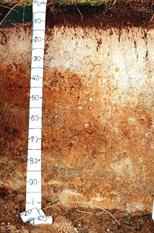The soils in the survey area were mapped as soil units;
Landscape Positions of Te Kowhai - Bruntwood - Horotiu Soils
The Hinuera Formation is the main parent material of the soils mapped in this survey.
It consists of weathered alluvial material that contains silt, sand and gravel deposited by the Waikato River when it was in the form of a braided river.
Three of the soil series in the mapping area are influenced by peaty material, with some of the soils having both peaty and humic topsoils.
From north to south across the survey area, the topsoil changes from peaty through humic to become a more mineral horizon.
The Te Rapa soils illustrate this phenomenon, their topsoil altering from peaty to humic in a southerly direction.
Ash and tephra deposits are visible in the topsoil of some of the soils in the form of silty mottles that can vary in size. These volcanic deposits would have had a negligible effect on the soils in the mapping area.
These deposits are typically more important to the soils that are found in elevated areas such as the low rolling hills that surround the Waikato Basin.
Matangi Silt Loam
The Matangi silt loam is thought to be a new soil since there are few if any references to it in the literature.
This soil is similar to the Ngaroto soils, but the Matangi soil has silt loam textures in the topsoil and upper subsoil, unlike the sandy loam textures of the Ngaroto soils.
The Matangi soil has features in its profile such as mottles and low chroma colours that indicate the soil is poorly drained. The drainage of this soil could be a relic feature - the drainage history of the soil on this farm is not known.
 |
|
Matangi Silt Loam
|
|
 |
the soil within a boundary can have variations in profile descriptions |
 |
inclusions of a different kind of soil sometimes occur in a unit.
|
Inclusions were generally too small to be mapped separately, but there are some areas on the map where more significant areas of a different soil type were able to be mapped as separate units (e.g. auger descriptions 99 and 66).
Some of the soils described and mapped are very much affected by changes in the topography: the Horotiu, Bruntwood, and Te Kowhai soils are found in specific positions within the landscape. Topographic changes in the survey area can be quite subtle so the profile descriptionsbecame important to mapping the soil boundaries.